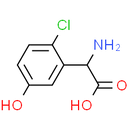Description
CHPG is a selective mGluR5 agonist, and attenuates SO2-induced oxidative stress and inflammation through TSG-6/NF-κB pathway in BV2 microglial cells. CHPG protects against traumatic brain injury (TBI) in vitro and in vivo by activation of the ERK and Akt signaling pathways.
Product information
CAS Number: 170846-74-9
Molecular Weight: 201.61
Formula: C8H8ClNO3
Chemical Name: 2-amino-2-(2-chloro-5-hydroxyphenyl)acetic acid
Smiles: NC(C1=CC(O)=CC=C1Cl)C(O)=O
InChiKey: UNIDAFCQFPGYJJ-UHFFFAOYSA-N
InChi: InChI=1S/C8H8ClNO3/c9-6-2-1-4(11)3-5(6)7(10)8(12)13/h1-3,7,11H,10H2,(H,12,13)
Technical Data
Appearance: Solid Power
Purity: ≥98% (or refer to the Certificate of Analysis)
Solubility: Soluble in DMSO.
Shipping Condition: Shipped under ambient temperature as non-hazardous chemical or refer to Certificate of Analysis
Storage Condition: Dry, dark and -20 oC for 1 year or refer to the Certificate of Analysis.
Shelf Life: ≥360 days if stored properly.
Stock Solution Storage: 0 - 4 oC for 1 month or refer to the Certificate of Analysis.
Drug Formulation: To be determined
HS Tariff Code: 382200
How to use
In Vitro:
CHPG (10-500 µM; 24 hours) significantly increases the cell viability and decreases the LDH release after SO2 derivatives treatment. CHPG (0.5 mM; 30 mins ) protects BV2 cells against SO2-induced apoptosis. CHPG (0.5 mM; 30 mins) treatment alone increases the expression of TSG-6 in both mRNA and protein levels.
In Vivo:
CHPG (injection; 250 nM; for 7 days) reduces significantly cerebral lesion volume.
References:
- Qiu JL, et al. The selective mGluR5 agonist CHPG attenuates SO2-induced oxidative stress and inflammation through TSG-6/NF-κB pathway in BV2 microglial cells. Neurochem Int. 2015 Jun-Jul;85-86:46-52.
Products are for research use only. Not for human use.
Payment & Security
Your payment information is processed securely. We do not store credit card details nor have access to your credit card information.


